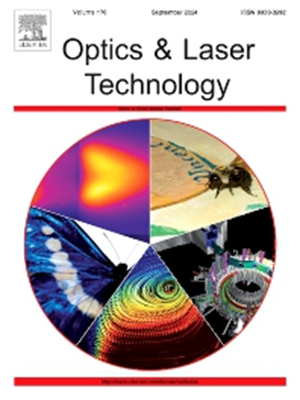Study on mechanism and characteristics of laser repair of surface damage after ultra-precision grinding of monocrystalline silicon
IF 4.6
2区 物理与天体物理
Q1 OPTICS
引用次数: 0
Abstract
The surface damage caused by ultra-precision grinding of monocrystalline silicon will affect the material performance and limit its application. In order to weaken or eliminate the surface defects and damages of monocrystalline silicon, laser repair research was carried out on the surface of monocrystalline silicon after ultra-precision grinding. The principle of laser repair of surface damage was described, and the relationship between laser damage threshold and laser power, ablation pore size and waist radius were clarified through theoretical model. A laser perforation experiment system based on grating scanning method was designed, and laser ablation pore sizes with different parameter combinations were obtained. Through analysis and calculation, it was determined that the damage threshold of monocrystalline silicon laser is 0.1188 ∼ 0.2419 J/cm2. The theoretical model of laser damage threshold and the experimental results of laser perforation showed that the energy density of laser repair should be below the laser damage threshold. The experiment results of laser repair showed that the higher the laser power is, the better the surface repair effect is. Surface laser repair result was relatively good at 20mW laser power. And the laser power over 40mW will also have a negative effect on the repair effect. The nanoindentation experiment of monocrystalline silicon material was carried out, and the results showed that the laser repaired monocrystalline silicon surface had higher ultimate fracture strength and plastic deformation than the original grinding surface. The results of Raman spectrum analysis showed that laser repair can transform the amorphous structure into single crystal structure in the ultra-precision grinding monocrystalline silicon material. The laser repair method of surface damage implemented in this study provides guidance and reference for the suppression and removal of surface damage of monocrystalline silicon and other hard-brittle materials.
求助全文
约1分钟内获得全文
求助全文
来源期刊
CiteScore
8.50
自引率
10.00%
发文量
1060
审稿时长
3.4 months
期刊介绍:
Optics & Laser Technology aims to provide a vehicle for the publication of a broad range of high quality research and review papers in those fields of scientific and engineering research appertaining to the development and application of the technology of optics and lasers. Papers describing original work in these areas are submitted to rigorous refereeing prior to acceptance for publication.
The scope of Optics & Laser Technology encompasses, but is not restricted to, the following areas:
•development in all types of lasers
•developments in optoelectronic devices and photonics
•developments in new photonics and optical concepts
•developments in conventional optics, optical instruments and components
•techniques of optical metrology, including interferometry and optical fibre sensors
•LIDAR and other non-contact optical measurement techniques, including optical methods in heat and fluid flow
•applications of lasers to materials processing, optical NDT display (including holography) and optical communication
•research and development in the field of laser safety including studies of hazards resulting from the applications of lasers (laser safety, hazards of laser fume)
•developments in optical computing and optical information processing
•developments in new optical materials
•developments in new optical characterization methods and techniques
•developments in quantum optics
•developments in light assisted micro and nanofabrication methods and techniques
•developments in nanophotonics and biophotonics
•developments in imaging processing and systems

 求助内容:
求助内容: 应助结果提醒方式:
应助结果提醒方式:


